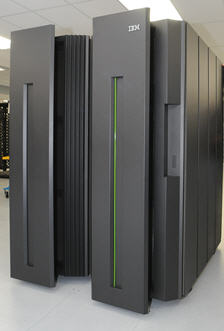IBM unveils hybrid mainframe; 'System of system' eyes data center consolidation

IBM on Thursday will unveil a new hybrid mainframe design that aims to cut data center sprawl and be a bridge to other systems.
All of the hardware giants---IBM, HP, Cisco, Dell and Oracle---are producing magic boxes (or armies of them) to modernize data centers and bridge them to cloud computing. IBM is ai
The lead-in to IBM's zEnterprise System (right) was interesting as rivals were pooh-poohing the effort before the launch. IBM CFO Mark Loughridge foreshadowed the mainframe launch during the company's earnings conference call.
What's the hubbub about? IBM is looking to bridge enterprises that run on mainframes with other industry standard servers. While hardware vendors take shots at each other, the reality is that most data centers have multiple hardware components. The key is to integrate those components, cut down on sprawl and save on energy---all while handling massive computing loads.
Also: As IBM preps mainframe launch, war of words with Oracle's Sun, HP heats up
The design was developed with $1.5 billion in R&D funding with input from 30 customers and more than 5,000 employees around the world. Will this effort work? Ultimately, the IT buyer will decide, but for now there are multiple moving parts to ponder. In a nutshell:
- The zEnterprise 196 is the core server in the package. It contains 96 processors running at 5.2 GHz each. The server can handle 50 billion instructions per second.
- IBM is looking to bring central governance and mainframe management tools and extend them to Power7 and System X servers. Think of IBM's new mainframes as a virtualization hub that manages other workloads in the data center.
- The new hybrid machines will offer faster analytics capabilities.
- zEnterprise will be up to 60 percent faster than the predecessor System z10 and use the same amount of energy.
- The system also rides shotgun with technology called IBM zEnterprise BladeCenter Extension and the IBM Unified Resource Manager to manage workloads across multiple systems.
As for the bottom line, IBM is claiming the zEnterprise System can reduce acquisition costs by 40 percent with total cost of ownership falling 55 percent.
IBM's move is likely to raise the debate about the mainframe, which has had obituaries written about it for years. Some companies, which are on the scale out with standard servers bandwagon, wouldn't be caught dead with mainframes. Enterprises that already have mainframes to process a massive amount of transactions---think financial services companies like Citi---will be receptive. Add it up and every big tech company has some spin on converging infrastructure to create efficient, automated computing systems. IBM has the same message with a mainframe twist.
In many respects, IBM is touching on the database and computing consolidation preached by Oracle with its Exadata machine. Here's an example from IBM's statement:
Using the zEnterprise System with the zEnterprise BladeCenter Extension and IBM zEnterprise Unified Resource Manager, a financial services company that is managing credit card transactions on the mainframe and using an IBM blade optimized for analytics, can gain insights from the information in seconds rather than waiting hours for the two disparate systems to integrate their databases. IBM estimates that complex database queries can experience up to a ten-fold performance improvement in this hybrid environment. In addition, with IBM's new architecture, the financial services company can extend the mainframe's unique, always-on, ultra-secure and reliable qualities to its customer service applications running on IBM blades.
If successful, folks may be calling for the demise of the mainframe another three decades from now.
Here's a deeper dive on the moving parts of the zEnterprise launch:
- The IBM zEnterprise BladeCenter Extension is designed to allow applications to be run on general purpose blade servers from Big Blue for specific tasks. These blade servers will be managed as if they were mainframes and be integrated with System z. IBM plans to launch blades running IBM's flavor of Unix, dubbed AIX. IBM next year plans multiple blades running Linux that will extend to the mainframe.
- IBM software called Unified Resource Manager will be the firmware that integrates computing resources so zEnterprise can manage it. One system can manage more than 100,000 virtual servers. Unified Resource Manager will also b able to find bottlenecks and failures and fix them.
- The zEnterprise 196 server is designed to optimize heavy workloads. IBM claims that the zEnterprise 196 will run Oracle workloads for 74 percent less than x86 systems. The system also has a water cooling system that can connect to standard chilled water systems in data centers. The server also has a bundle of IBM software from Tivoli and can be optimized to work with Cognos and SPSS for analytics. Rational and Lotus are also in the mix.
Separately, BMC Software, a leading mainframe software management company, said it will support IBM's hybrid mainframe with its Business Service Management tools. BMC sees the hybrid approach as a logical way to bring systems together. "IBM's mainframe approach brings the cloud opportunity to the forefront," said Bill Miller, president of BMC’s Mainframe Service Management business unit. "This could be a lot more than a traditional server and with its split personality could offer scalability like nothing else out there."
At the very least, IBM has another data center stack to evaluate.